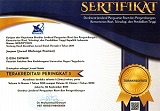Senam Ritmik Dalam Paradigma Era Globalisasi
DOI:
https://doi.org/10.21831/jorpres.v15i2.29512Keywords:
Senam ritmik, Globalisasi, Gymnastics, Rhytmic, GlobalAbstract
Senam merupakan cabang olahraga sangat popular dalam skala nasional hingga skala internasional, hal ini dapat dilihat dari popularitas senam yang dilakukan oleh anak usia dini, dewasa, hingga lanjut usia. Pada era globalisasi ini, senam telah masuk dalam berbagai olahraga dalam masyarakat, baik olahraga kesehatan, olahraga pendidikan, dan olahraga prestasi. Pada tahapan olahraga prestasi ini, senam terbagi menjadi beberapa kategori yang salah satunya adalah kategori senam ritmik. Dalam olahraga prestasi ada beberapa tahapan yang harus dilakukan untuk prestasi optimal seperti, pembinaan multilateral, pembinaan spesialisasi dini, dan pembinaan prestasi optimal. Salah satu pondasi dasar dalam pembinaan prestasi optimal adalah pembinaan multilateral. Dalam pembinaan multilateral ini menggunakan konsep latihan baru, yaitu adalah Coaching Games for Upgrading. Coaching Games for Upgrading merupakan kebaharuan model latihan di era globalisasi, pada tahap ini lebih menekanan model-model latihan yang sudah mulai mengarah terhadap cabang olahraga spesifik, dimana model latihan tersebut akan meningkatkan kemampuan komponen biomotor cabang olahraga, khususnya cabang olahraga senam ritmik.
Rhythmic Gymnastics in the Globalization Era Paradigm
Abstract
Gymnastics is a sport that is very popular on a national scale to an international scale, this can be seen from the popularity of gymnastics performed by young children, adults, to elderly people. Gymnastics is divided into several categories, one of which is the rhythmic gymnastics category. In this globalization era, gymnastics has entered various fields of sports, both sports health, sports education, and sports achievements. In sports, several stages of achievement must be done for optimal achievements such as multilateral coaching, early competence coaching, and optimal fostering achievement. One of the basic foundations in fostering optimal achievement is multilateral coaching. In this multilateral coaching, it uses a new training concept, which is a training game for improvement. Training game to improve is a model of the novelty of training in the era of globalization, in training exercises models that have begun to fight specific sports, where this training model will improve the ability of biomotor components of sports, a special branch of rhythmic gymnastics.
References
Bompa, T. (1999). Periodization, Theory and Methodology of Training. Iowa: Kendall Hunt Publishing Company.
Budi Sutrisno & Muhamad Bazin Khafadi. (2010). Pendidikan Jasmani Olahraga Dan Kesehatan 2. Jakarta: Pusat Perbukuan Kemendiknas 2010.
Goulart, A.T. (2004). A importí¢ncia da pesquisa e da extensí£o na formaí§í£o do estudante universitário e no desenvolvimento de sua visí£o crítica. Horizonte, 2(4), 60-73.
Harsono. (1988). Coaching dan aspek-aspek pisikologis dalam Coaching. Jakarta: CV Tambak Kusuma.
Margono, Agus. (2009). Senam. Surakarta: UNS Press.
Martins, R.E.M., Dias, J., & Martins Filho, L. J. (2016). The context of education, research and extension in teacher training at the College of Education, University of the State of Santa Catarina. Revista de educaí§í£o PUCCampinas, 21(2), 243-254. doi:https://doi.org/10.24220/23180870v21n2a2893
Siswantoyo, Mansur, Norkhalid, Izwan. (2018) . Pengembangan Coaching Games For Upgrading Performance Model. Universitas Negeri Yogyakarta.
Tardif, M. (2014). Saberes docentes e formaí§í£o profissional. Petrópolis: Vozes
Tohar. (2004). Ilmu Kepelatihan Lanjut. Semarang: FIK Yogyakarta
Tudor.O. Bompa, Gregory Haff. 2009. Periodization Theory and Methodology of Training. 5th ed. USA.Human Kinetic.
Undang-Undang Republik Indonesia Nomor 3. Tahun 2005. (2007) Tentang Sistem Keolahragaan Nasional. Kementerian Negara Pemuda dan Olahraga Republik Indonesia. Jakarta.
Downloads
Published
How to Cite
Issue
Section
License
Authors who publish with this journal agree to the following terms:
- Authors retain copyright and grant the journal right of first publication with the work simultaneously licensed under a Creative Commons Attribution License that allows others to share the work with an acknowledgement of the work's authorship and initial publication in this journal.
- Authors are able to enter into separate, additional contractual arrangements for the non-exclusive distribution of the journal's published version of the work (e.g., post it to an institutional repository or publish it in a book), with an acknowledgement of its initial publication in this journal.
- Authors are permitted and encouraged to post their work online (e.g., in institutional repositories or on their website) prior to and during the submission process, as it can lead to productive exchanges, as well as earlier and greater citation of published work (See The Effect of Open Access).




